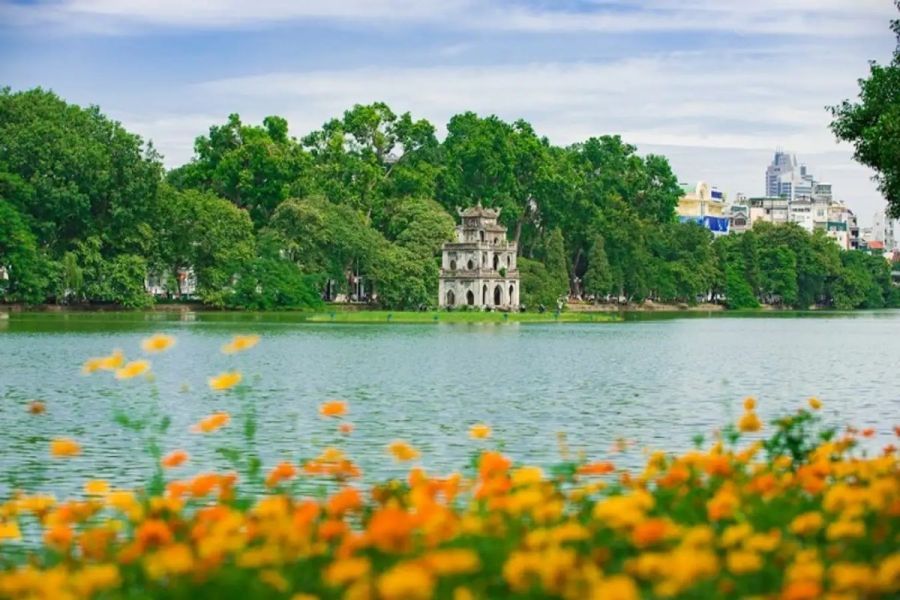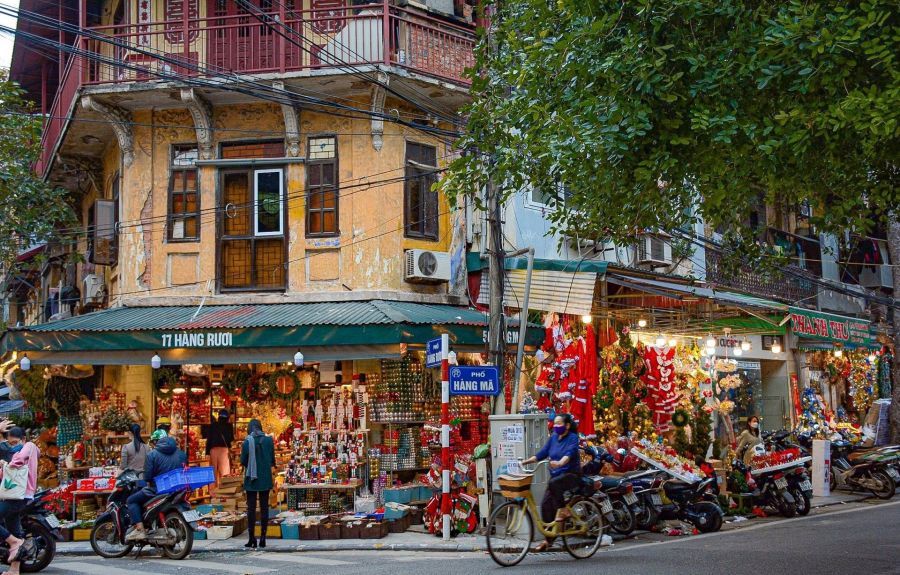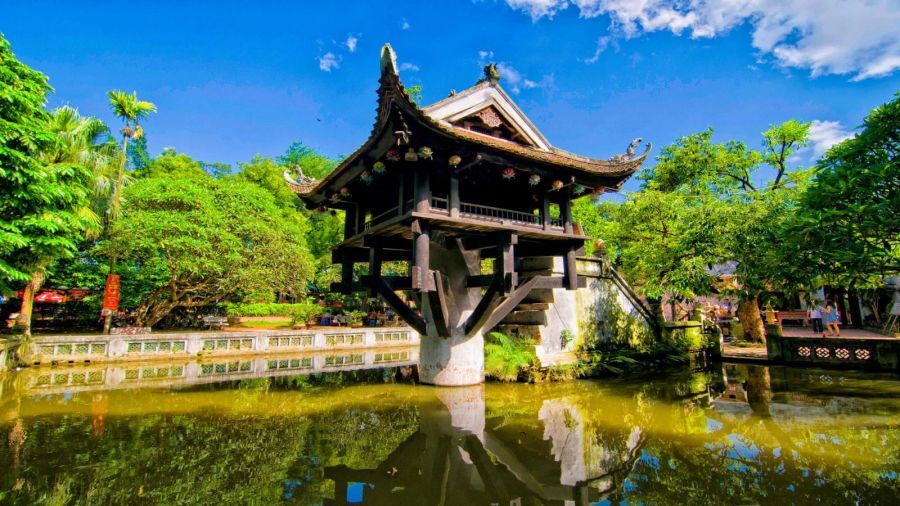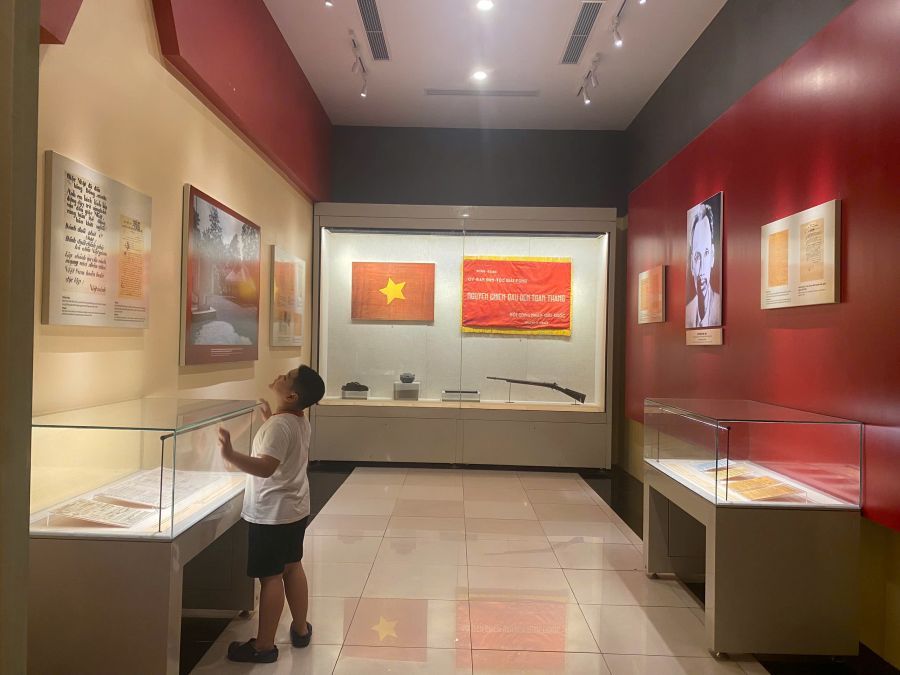Top 6 Must-Visit Temples In Hanoi For A Spiritual Trip
Temples in Hanoi exemplify the soul of the city and its rich history. The capital has many sacred temples, allowing visitors to enjoy a worldly feel while partaking in breathtaking architecture, mythical legends, and festivals celebrating the city’s ancient culture.
Table of Contents
ToggleNgoc Son Temple
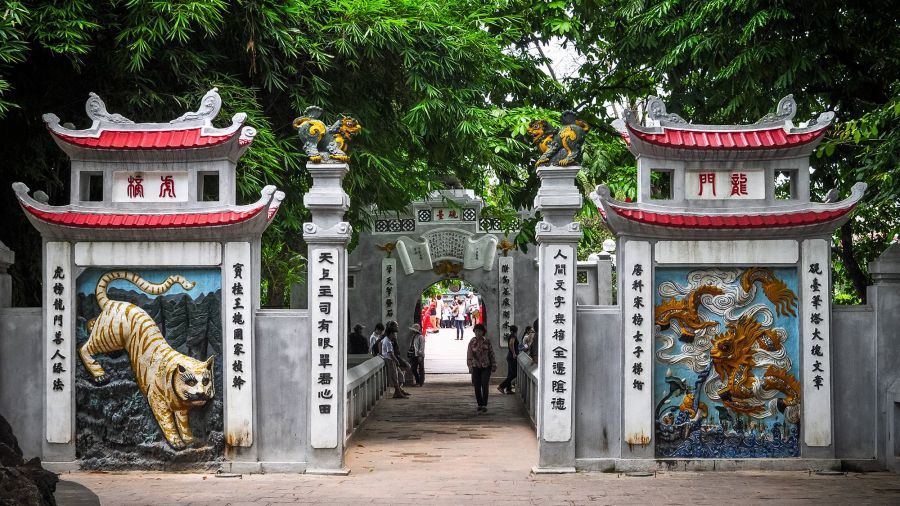
- Location: Dinh Tien Hoang Street, Hang Trong Ward, Hoan Kiem District, Hanoi
Located on Hoan Kiem Lake, Ngoc Son Temple, or “Temple of the Jade Mountain”, rests on Jade Island among lush gardens and ancient trees. The red-painted The Huc Bridge connects the temple with the mainland. This historic temple was built in the 19th century to honor General Tran Hung Dao, who thwarted a Mongol invasion in the 13th century.
Within the temple, traditional Vietnamese architecture is found in the wooden statues and altars. The temple also has significant artifacts that make it culturally relevant. The peaceful courtyard and intricate carvings, as well as the Confucianism, Taoism, and Buddhist elements, make it a spiritually developed area and link to the Vietnamese way of life. The tranquil setting provides visitors with time to reflect and enjoy the heritage of Vietnam.
The beauty of Ngoc Son Temple comes to life, particularly at sunrise or sunset, when the lake glimmers and the only sounds are those of the lake. Whether you love history or wish for a quiet stroll, this temple distills the culture and charm of the city.
Bach Ma Temple
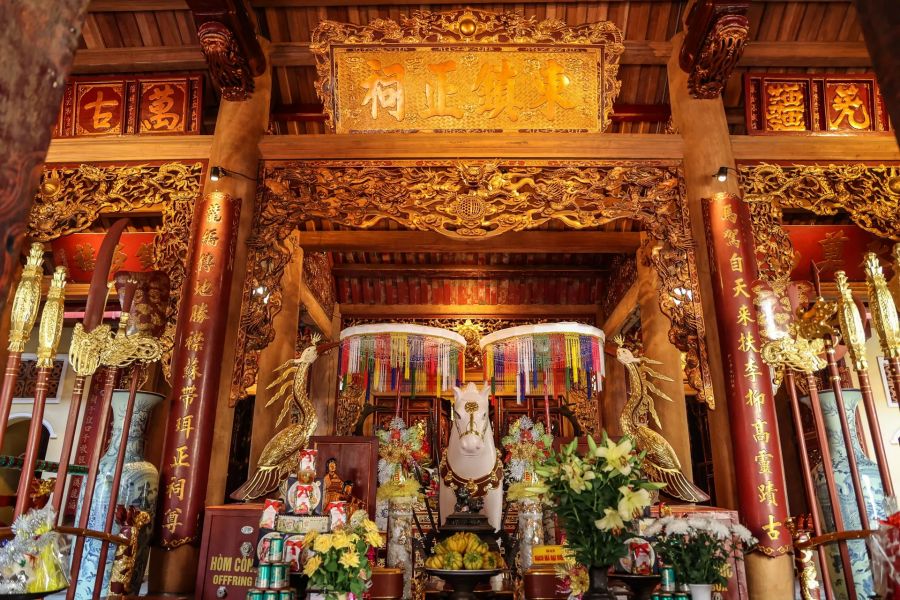
- Location: 76 Hang Buom Street, Hang Buom Ward, Hoan Kiem District, Hanoi
Bach Ma Temple is recognized as Hanoi’s oldest temple, located at 76 Hang Buom in the Old Quarter. The temple was originally built in the 9th century, then reconstructed on the orders of King Ly Thai To, a century later, to honor the White Horse deity who led him to establish an ancient citadel known as Thang Long. This connection to the White Horse deity is the inspiration for the temple’s name; “Bach Ma” translates to “White Horse”.
The temple epitomizes Vietnamese architecture, with wooden pillars, detailed carvings, and altars decorated in red lacquer and gold paint. Statues of the White Horse and other historical figures, incense offerings, and ancient artifacts that mistake a representation of the spiritual life of ancient Hanoi, occupy the interior of the temple. Despite being situated on a busy street, the temple space is tranquil and reflective of the solemnity it embodies.
As a visitor to Bach Ma Temple, you are walking through the legends of Hanoi’s history, and one of its most revered religious sites. It is also a good stop-off for those traveling interested in culture or architecture, or active travelers wanting to experience some of the traditional spiritual customs of Hanoi that have been practiced for in excess of one thousand years.
Quan Thanh Temple
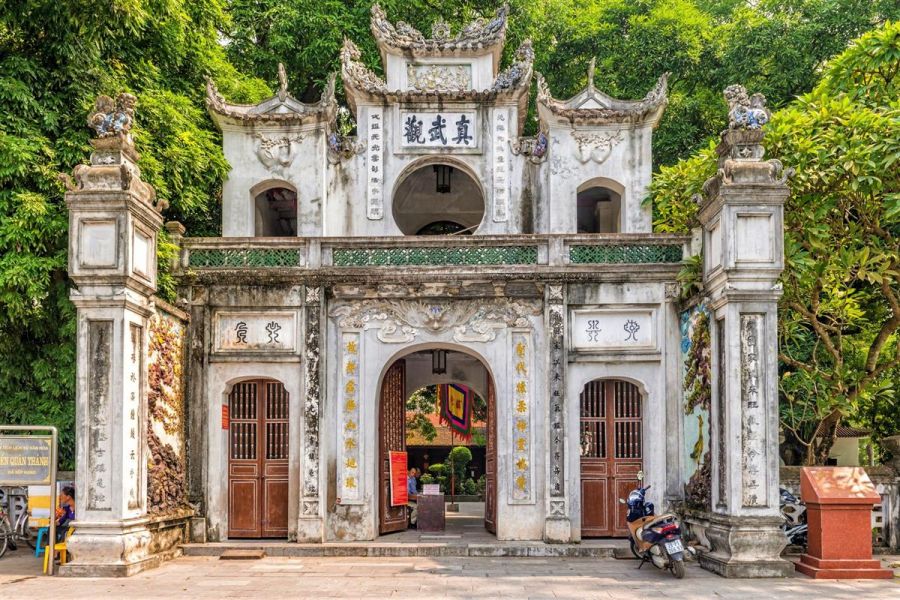
- Location: 190 Quan Thanh Street, Quan Thanh Ward, Ba Dinh District, Hanoi
Quan Thanh Temple is a notable place of worship located today not far from the northern gate of the Old Quarter, next to Truc Bach Lake and West Lake. It was built during the Ly Dynasty, over 1,000 years ago, to honor Tran Vu, a Taoist deity believed to protect the North and deliver peace and prosperity. The location of the temple is serene, and the peaceful setting appeals to both worshippers and tourists alike.
The temple architecture features ancient wooden temples and a large bronze statue of Tran Vu that is nearly four meters high, and an intricately designed bronze bell dated to the 17th century. The statue is one of the most notable bronze artworks in Vietnam. It symbolizes physical strength and power to be used for protection. The courtyards nearby, accompanied by bonsai trees and the sounds of bells, create a peaceful, almost meditative aura.
A trip to Quan Thanh Temple will provide a rich understanding of Hanoi’s religious history and traditional craftsmanship. A visit to this temple should be on your checklist if you are interested in Taoist culture, Vietnamese history, or simply looking for a moment of serenity lakeside during your travels in Hanoi.
Voi Phuc Temple
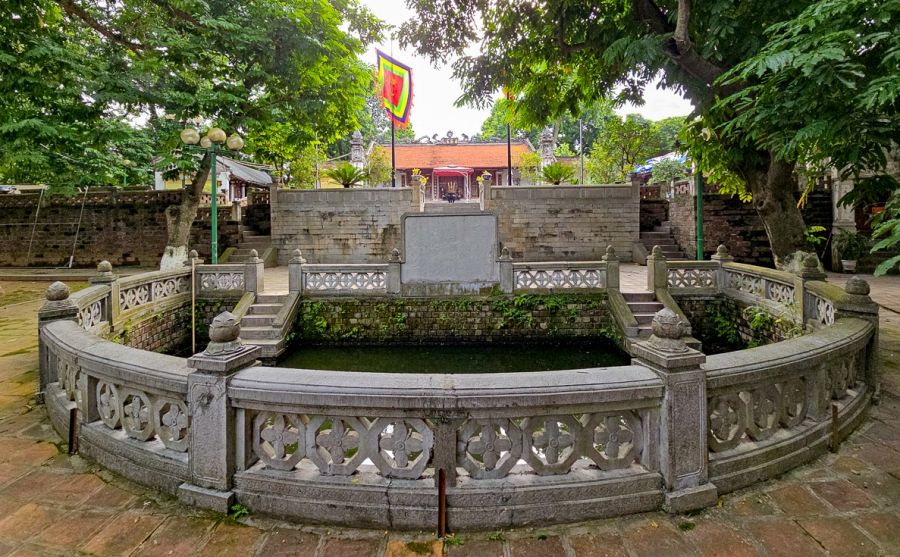
- Location: 306B Kim Ma Street, Ngoc Khanh Ward, Ba Dinh District, Hanoi
Voi Phuc Temple, also known as the “Temple of Kneeling Elephants,” can be found in the Ba Dinh District of Hanoi, near the famous Thu Le Park. Constructed during the Ly Dynasty, the temple is devoted to Prince Linh Lang, who was a legendary hero during a time when foreign invaders posed a serious threat. The name of the temple comes from two stone elephants depicted kneeling at the gate of the temple, representing loyalty and courage.
The temple architecture, inside and out, is traditional Vietnamese architecture with a curved tiled roof, wooden pillars, and intricate carvings. Inside the temple are ancient altars, ceremonial items, and smoke-wreathed halls that tell wonderful stories of national pride and devotion. A quiet courtyard sheltered by trees makes a peaceful escape from the noise and light of the city.
Voi Phuc Temple is not only a spiritual destination, but it is also culturally significant. It preserves cultural aspects of Vietnam’s rich history. It is an ideal stopping point for those wanting to experience the sacred heritage of Hanoi while enjoying a gentle, reflective space.
Ba Kieu Temple
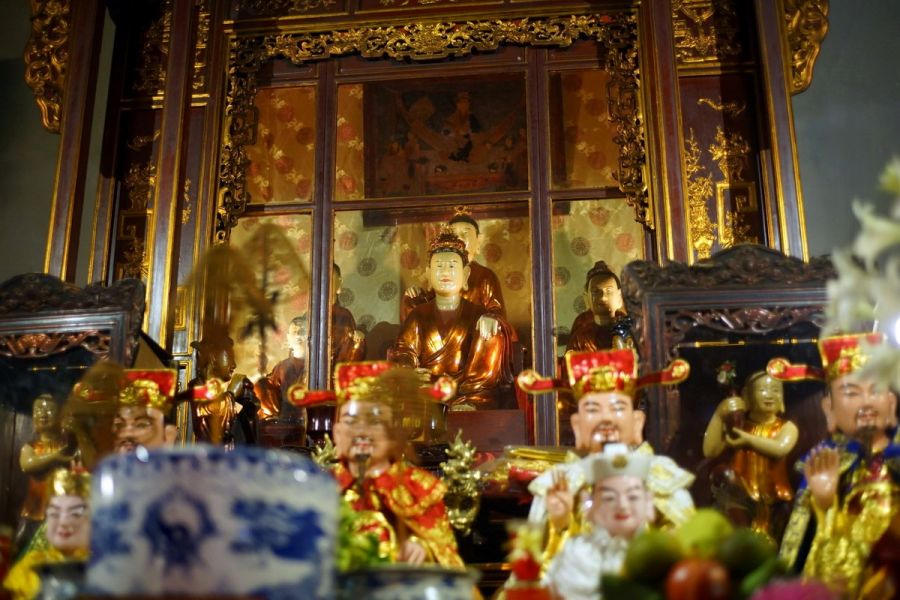
- Location: 59 Dinh Tien Hoang Street, Hang Trong Ward, Hoan Kiem District, Hanoi
Ba Kieu Temple is an important religious site in Hanoi, located close to Hoan Kiem Lake. The temple is dedicated to three goddesses of traditional Vietnamese origin, Princess Lieu Hanh, Quynh Hoa, and Que Hoa, who are important symbols in the Vietnamese Mother Goddess religion (Dao Mau) for strength, love, and protection.
The temple has a nice wooden structure with wooden carvings everywhere and pretty altars with offerings of flowers and food in colorful dishes. It has an atmosphere of peace and is a beautiful escape from the busy Old Quarter, so it is a popular spot for worshippers and visitors alike.
Ba Kieu Temple is an important site for the conservation of traditional beliefs and values. People visit Ba Kieu Temple to light incense, pray for luck, and learn about these unique Vietnamese spiritual traditions.
Kim Lien Temple
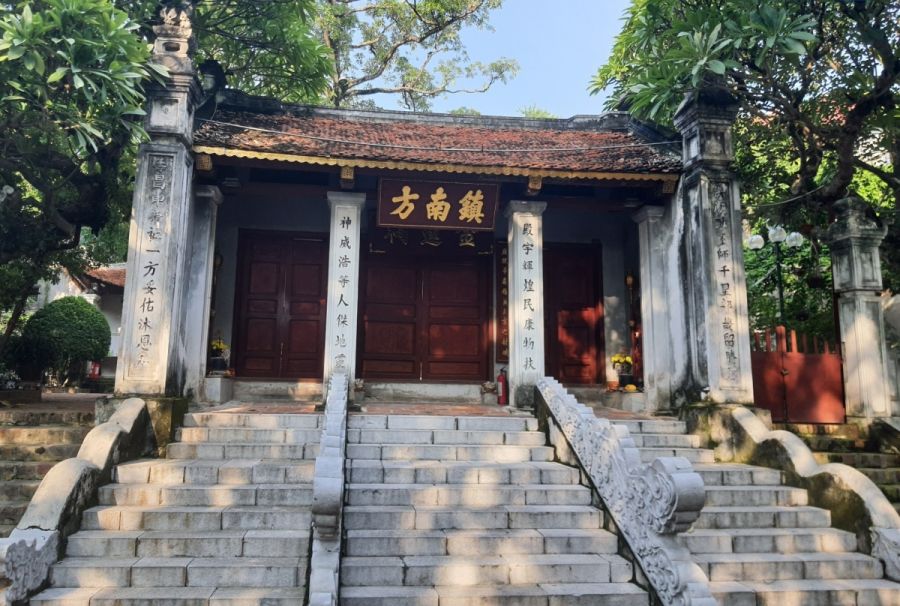
- Location: 148 Kim Hoa Street, Phuong Lien Ward, Dong Da District, Hanoi
Located to the south of Hanoi, Kim Lien Temple is a culturally important spiritual address to Cao Son Dai Vuong. Traditionally, he is thought to be a son of Lac Long Quan and Au Co, and one of fifty children who followed their mother into the mountains. He collaborates with Son Tinh to defeat Thuy Tinh to protect the people from floods.
Historically, King Ly Thai To built Kim Lien Temple after establishing the capital at Thang Long to protect the south gate of the city. In 1509, General Le Tuong Duc prayed at Kim Lien Temple when he was marching to overthrow King Le Uy Muc. After he had won, he rebuilt the temple on a larger scale, and a triple-gated entrance and other additions by local people created what we see today as the Kim Lien communal complex.
The temple features many examples of Nguyen Dynasty architecture with carved motifs and detailed wooden decorations. As in many temples in Vietnam, the central hall includes three main structures: a ceremonial gate, a worship hall, and a sacred sanctuary. Within the temple are several relics, including a stone stele from 1772 and 39 official royal decrees praising the deity. Each year on the 16th day of the third lunar month, the Kim Lien villagers perform a traditional festival, repeating rituals to honor and giving thanks to God.
FAQs About Temples In Hanoi
Hanoi temples can be sites of worship, but also include historical and cultural implications. Below are some frequently asked questions that may help you better plan your visit:
Which temples are popular to visit in Hanoi?
Some of the more notable temples to visit are Ngoc Son Temple, Quan Thanh Temple, Kim Lien Temple, and Voi Phuc Temple. Each temple is important in Vietnamese culture and has an interesting story.
Are there admission fees to visit temples in Hanoi?
Most of the temples have no admission cost to enter, although many may ask for a small donation or have a modest entry fee to maintain the premises.
What should I wear when visiting a temple in Hanoi?
Visitors entering a temple in Hanoi should dress modestly with clothing that covers their shoulders and knees. It is preferable to avoid sleeveless clothing exposing shoulders, along with short skirts or shorts.
Can I take photos inside temples in Hanoi?
Photography is usually allowed in outdoor areas of the temple; however, you should check for signage that prohibits photography or ask permission if you are unsure about taking photos inside the sacred spaces.
When is the best time to visit temples in Hanoi?
Typically, the early morning or late afternoon is the best time to avoid both heat and crowds. Spring and autumn are much nicer times for temple visits, too.
Are Hanoi temples open all year round?
Yes, the majority of temples are open every day of the year, although the opening hours may slightly differ depending on location.
Can I take part in any rituals or ceremonies during my visit to the temples?
In some temples, it is often possible to observe or even take part in public ceremonies, especially when it is a major festival, e.g., Tet or the Lunar Full Moon.
Final Thoughts
Hanoi is a city filled with a myriad of temples, which embody the depth of its cultural and spiritual heritage. Each of these locations, from Ngoc Son Temple to Quan Thanh Temple, tells a story that has existed forever. If you are looking for tranquility, a beautiful place to spend a few hours, or a deeper relationship with Vietnamese history, then these spiritual sites of Hanoi are perfect for you. Explore the best temples in Hanoi and around Vietnam with Seni World today!








